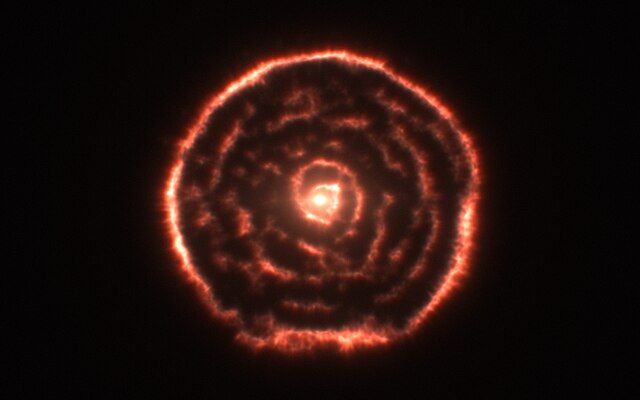VY Canis Majoris is an extreme oxygen-rich red hypergiant or red supergiant and pulsating variable star 1.2 kiloparsecs from the Solar System in the slightly southern constellation of Canis Major. It is one of the largest known stars, one of the most luminous and massive red supergiants, and one of the most luminous stars in the Milky Way.
Portrait in bust of Jérôme Lalande in 1802
Combined optical and infrared image of VY CMa. The bright star at the upper right is τ Canis Majoris. (ESO/Digitized Sky Survey 2)
VLBA used to derive VY CMa's 2011 distance estimate
(July 2008, outdated). Relative sizes of the planets in the Solar System and several stars, including VY Canis Majoris: 1. Mercury < Mars < Venus < Earth 2. Earth < Neptune < Uranus < Saturn < Jupiter 3. Jupiter < Proxima Centauri < Sun < Sirius 4. Sirius < Pollux < Arcturus < Aldebaran 5. Aldebaran < Rigel < Antares < Betelgeuse 6. Betelgeuse < Mu Cephei < VV Cephei A < VY Canis Majoris.
In astronomy, stellar classification is the classification of stars based on their spectral characteristics. Electromagnetic radiation from the star is analyzed by splitting it with a prism or diffraction grating into a spectrum exhibiting the rainbow of colors interspersed with spectral lines. Each line indicates a particular chemical element or molecule, with the line strength indicating the abundance of that element. The strengths of the different spectral lines vary mainly due to the temperature of the photosphere, although in some cases there are true abundance differences. The spectral class of a star is a short code primarily summarizing the ionization state, giving an objective measure of the photosphere's temperature.
UGC 5797, an emission-line galaxy where massive bright blue stars are formed
Artist's impression of a Y-dwarf
Image of the carbon star R Sculptoris and its striking spiral structure
Sirius A and B (a white dwarf of type DA2) resolved by Hubble








